| |
Alopecia - This is the term used for bald spots. The
most common is the bare spot on the bridge
of the nose. More common in summer months, it can be caused by fly irritation
and rubbing. For this problem, some owners have found improvement by applying
Conofite, Vitamin E Oil, Vaseline, or Preparation H to the area.
The wool on the bridge of the nose normally grows
back in winter months if not before.
If the area with hair loss is crusty, flaky, thickened or reddened,
one may have to suspect ringworm, mange, mites, a type of fungus, rain scald, or zinc responsive skin disease
(sometimes called elephant skin). When the wool is coming out or breaking off, but
not
leaving a bald spot, it
may be due to shedding or a wool break due to some stress or illness.
Often this will occur when a llama goes to a new home or births a cria for the
first time. |
Mites
This Case Has Not Been Clinically Diagnosed
|
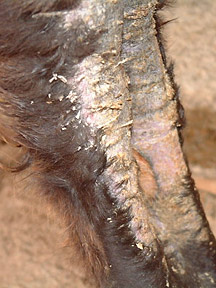
|
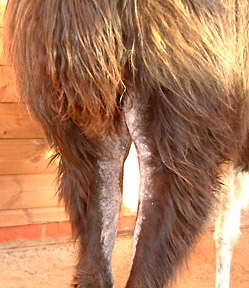
| | Notes From
Owner: Began with loss of hair and then gradually the bald patches increased in size, thickly encrusted with a greyishness or sometimes simply reddish in
color. In one or two areas the skin has cracked and bled. The affected area, now extensive, is the inner thighs, now completely stripped of hair, and the anus region. It seems the front legs are beginning to be affected too. While this condition is unsightly and very disturbing to me,
Maryann seems completely unaware of it. There is no apparent itching and none of the limping which would indicate soreness.
Her field here in southern England is poorly drained clay of neutral to acid soil. By avoiding over-stocking, we manage to keep all but the gate areas free of mud. Temperatures of late include nights below freezing,
in case this is relevant. She lives with four male llamas - none of which show any sign of the problem. |
Suggestions from other
llama owners:
1. One
owner suggests that these pictures look just like a mite problem that he had on
one of his animals. Injectible Ivermectin or Dectomax should take care of mites.
A skin scraping from the outer edge of the area would determine if it was mites or a type of fungus.
He then treated it with good old fashioned lime sulfur spray. He drenched
the area well twice a day.
2. Another owner suggests that this could also be a type of fungus. This farm
treats a skin fungus with a Betadine or Iodine Scrub and then follows up with
applications of fungal shampoo or medications. Sometimes fungal infections
can be very very difficult to clear up.
3. Another Owner: I have been fighting the exact same thing on one of our older girls. I
finally got a hold on it by bathing the affected areas with a copper based soap and treating with
dectomax. I did a skin scraping and had no doubt it was mites!!!! Watch your other animals
closely, especially the young and old................it is highly contagious. I
also used Cylence on the whole herd.
4. Another Owner: My vet suggested using Bag Balm on the
area. It prevents the air from getting to the area and allows it to
heal.
|
More Suspected Mites
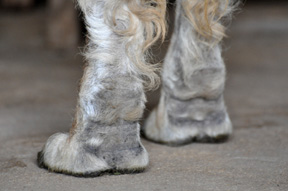 |
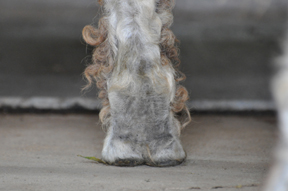 |
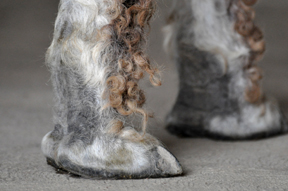 |
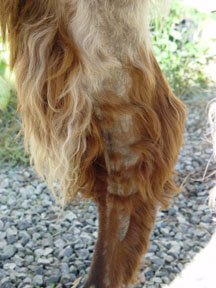 |
These photos show the loss of wool on legs of llamas
from mites. These animals were treated with Dectomax, 1 cc per 100
lbs., and the bare areas stopped spreading. |
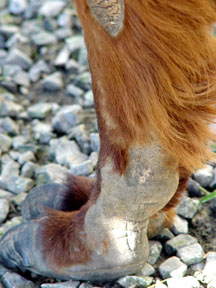 |
Ringworm
|
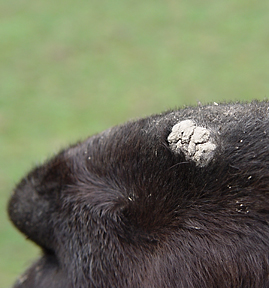
|
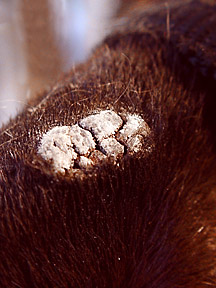
|
|
These are photos of a spot of Ringworm
on a llama's nose. This case was clinically diagnosed by a skin
culture. |
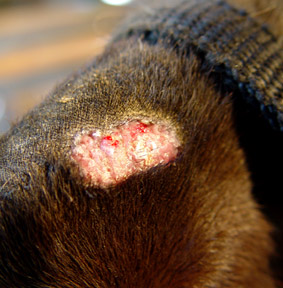 |
Ringworm is not actually a worm, but rather a type
of fungi. And the skin lesion is not always in the form of a ring.
This species of fungi are sometimes found as normal inhabitants of soil,
however, it may also be found in contaminated pens. Highly
contagious, it is easily spread from animal to animal - but rarely to
humans although it is a possibility.
Arthrospores, the infective element of this fungi, invade the hair
shafts and the outer layer of skin resulting in hair loss and a crusty
appearance. It most often appears on the face, the legs, or the
feet.
The photo on the top left was first noticed on the side
of the animal's nose. The photo on the top right is a close up view.
The photo just to the left is the area after it was cleaned with Betadine and
the crustiness removed. It was then treated with an anti-fungal cream
which took care of the problem immediately. It takes a few weeks before
you notice the hair starting to grow back on the area. Wash hands
thoroughly after administering treatment.
Treatment: Topically, treat with tincture of
iodine or Betadine. Apply with a cotton swab so as not to get
any in eyes etc - can be very irritating. Apply an anti-fungal
ointment - Lotrimin is good. Apply every other day for 1 week. |
|
This photo below is of Ringworm on the side of the face just
above the mouth. The crusty spot was removed and it was treated
topically with Iodine. A follow up treatment of Confite, an
anti-fungal ointment, was done a couple of days later. |
 |
 |
|
Ringworm on the Foot
Ringworm on the foot being treated with Iodine after the
crustiness has been removed. |
|
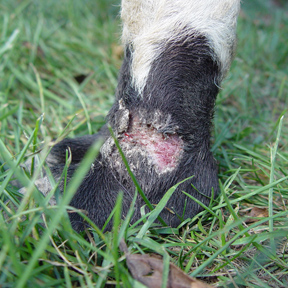
|
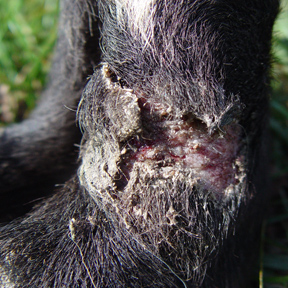
|
|
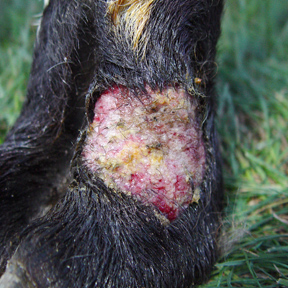 |
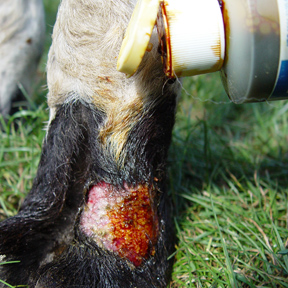 |
Munge
|
Munge appears as a crusty crud or pustular dermatitis
generally around the mouth and nose. Lesions may include thickening and
cracking of the skin at the corners of the mouth and crusty scales on the
lips and nose. Most cases of munge appear in animals 6 mo to 2 years of
age. Cause is unknown. It may be the result of a bacterial infection,
fungal infection or constant contact with an irritant like wet grass.
Skins scrapings should be done to rule out ringworm or mites. Suggested
treatment is iodine scrubs. Some owners have had success with the use of a
mixture called Witches Brew.
|
|
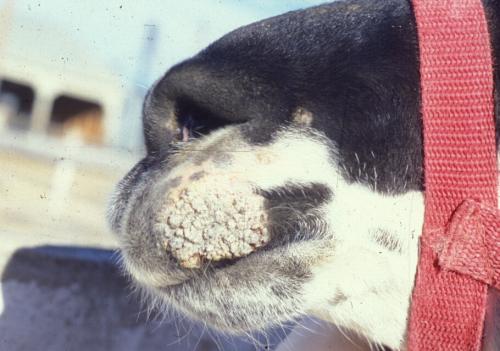 |
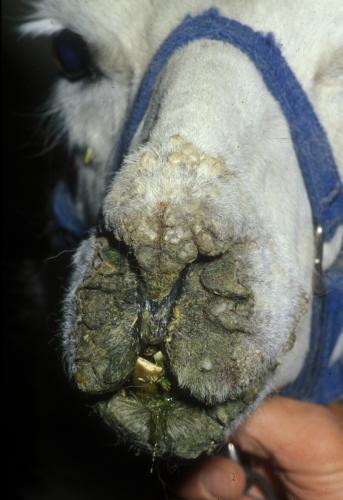 |
|
More information on Munge here.
More information on Mites & Mange & Witches Brew
here.
|
Soremouth
also called
Contagious Ecthyma, Scabby Mouth, Orf, Pustular
Dermatitis
|
Soremouth is also known as contagious ecthyma, orf,
scabbby mouth, or pustular dermatitis. It's caused by a virus that is a
member of the poxvirus group and can survive for long periods in scabs
that drop into the environment from infected animals.
Animals infected with this virus typically develop
scabby sores (lesions) around the corners of their mouth, lips, muzzle,
and possibly in their mouth. Sores appear as blisters early in the
infection and then develop into crusty scabs. Young animals are more
susceptible than adults and may spread it to the udder or teats of their
nursing mothers. Munge is another disease that has similar symptoms.
This disease can occur in most small ruminants -
alpacas, llamas, sheep, goats, and other wild ruminants. The sores or
scabs are usually seen in 2-3 days after exposure to the virus. Exposure
occurs by direct contact with skin lesions or scabs of infected animals.
Soremouth will last about 1-4 weeks and will normally heal itself as scabs
fall off and the tissues heal.
Treatment is usually not successful. Because it is a
virus, soremouth doesn't respond to antibiotics. However, you may see the
lesions respond slightly to a treatment of an iodine scrub and
applications of an antibiotic cream. The disease must run its course,
normally about one month. It's not recommended that you remove the scabby
crusts as you may delay healing and increase your chance of getting the
virus.
This virus is contagious and it's possible for humans
to get it. Contagious ecthyma in humans is called orf. For prevention,
use gloves when treating your animals and wash your hands thoroughly.
Typically, in humans, a lesion will appear on your hand and will heal on
its own in 2 to 4 weeks.
|
|
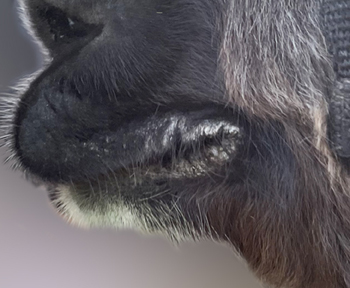
Suspected Soremouth - scabby bumps in corner of the mouth. |
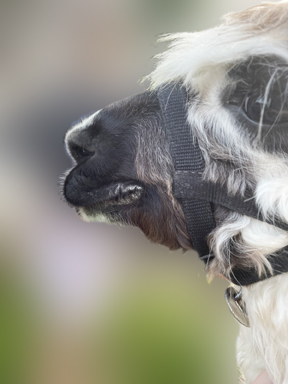 |
|
|
Shearing Burns
|
Skin conditions associated with shearing are more common than thought. Hot
shears may cause burns that result in bare spots or thick scabs usually on the
back and sides of the animal. These spots may resemble "wool rot" or
mites. Noting shearings by those not familiar with the shears helps to
confirm the diagnosis. |
|
|
|
|
|
|

Return To Llama Care
Disclaimer
All information on this website is provided as a public service, but we
cannot guarantee that this information is current or accurate. Readers
should consult with their veterinarian before acting on any treatments.
This document is copyrighted by Shagbark Ridge Llamas and no
part may be copied to another homepage. Permission is granted to link
to this page, copy this document in electronic form, or to print it for
personal use provided that this copyright notice is not altered or removed.
Updated Frequently
Shagbark Ridge Llamas

|